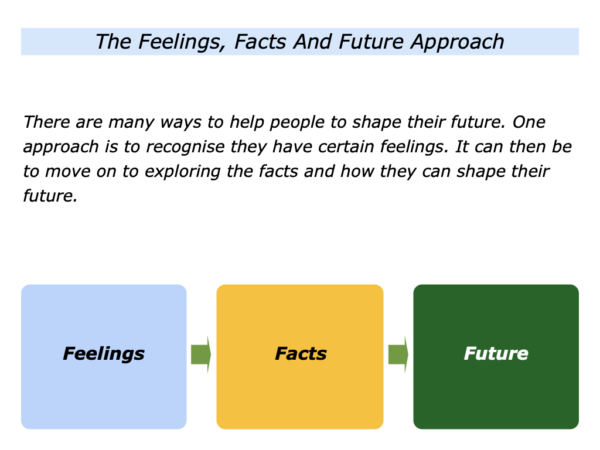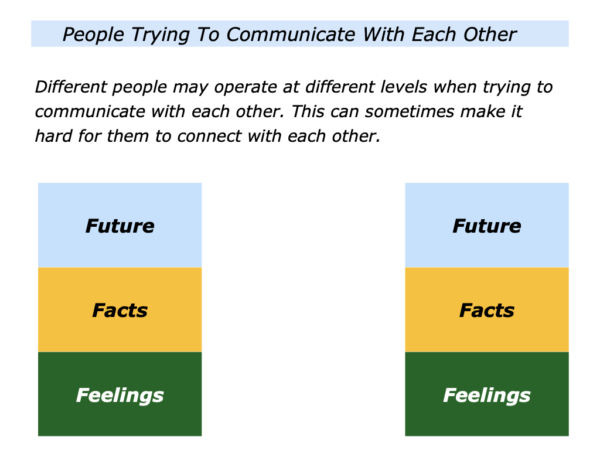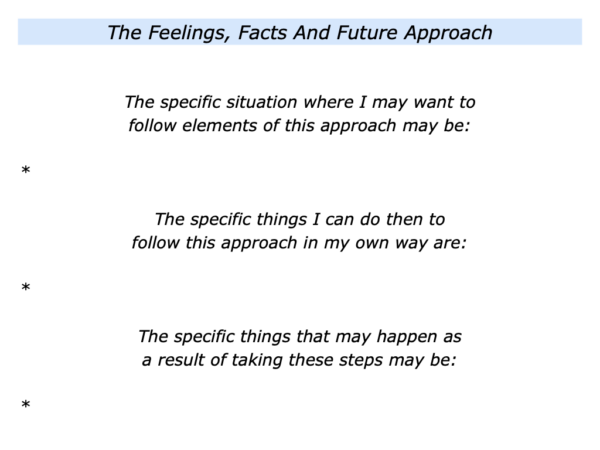
There are many ways to help people to shape their future. One approach is to recognise that people may have certain feelings. It can then be to move on to exploring the facts and helping them to shape their futures.
One crucial point is to recognise when it is appropriate to move on from the feelings aspect. There are many ways to do this in a caring way. Let’s look at one example.
A doctor who is giving somebody bad news will recognise the importance of a patient’s feelings. They may say something like the following.
“We have got the results back. Unfortunately it is not good news. There are, however, several possible ways forwards.
“I recognise that this may come as something as a shock, so you may need time to reflect. I can also give you any more information you want to know about the results.
“When you are ready, but only when you feel it is appropriate, we can explore the possible ways forward.
“There are several different routes we can take. Each route has pluses and minuses. It is important that you know the implications about each route.
“First of all, however, I can give you any information you want to know about the present situation and the possible ways forwards.”
Good communicators also recognise that people have different ways of operating. They therefore aim to communicate in ways that connect with different people. Here are three different ways that people operate. These are extremes, of course, and people often blend these approaches.
Feelings
Some people mainly operate and talk on the level of feelings. Their feelings are real for them and they want these to be respected.
They may have difficulties with people who – for various reasons – may not believe that the person’s feelings are justified or who simply want to talk about facts.
Facts
Some people mainly operate and talk on the level of facts. They can find it difficult to communicate with those who operate on the level of feelings.
The classic example is when the feelings person says: “I feel …”
The facts person responds by saying: “But that is illogical. Here are the facts.”
Future
Some people operate by focusing on the future. Whatever the situation, they may quickly move into solutions mode or setting positive goals.
Such people do have feelings and explore facts. They quickly channel these into towards at the future, however, and how to achieve success.
People sometimes get into difficulty when communicating with each other because they operate in different ways. One person may want to talk about their feelings, for example, but the other person wants to talk about the facts or the future.

Good therapists recognise the people may operate at different levels. They often start on the level at which the other person is operating. They then aim to help them to shape their future.
When working with a feelings person, for example, they will show that they recognise that the person’s feeling is authentic. This does not mean that:
They personally have the same feeling … They are saying the feeling is justified … They are prepared to accept how the person behaves in the way they express this feeling.
When I worked as a therapist, if a person said: “I feel …” I would ask: “What do you want to feel in the future?” We then explored how they increase the likelihood of experiencing that feeling.
Good communicators take similar steps when encouraging people to work towards a positive vision. They sometimes do this by taking the following steps.
They show they recognise the authenticity of people’s feelings;
They then, when appropriate, focus on the facts and show the possible ways forwards that people can follow to shape a positive future.
Looking ahead, can you think of a situation where you may want to follow elements of this approach? You may want to help a person to deal with a setback, take the next step in their career, deal with a challenge or reach a specific goal.
What can you do to recognise the person’s feelings? When appropriate, how can you encourage them to explore the facts and shape their future? What may happen as a result of taking these steps?
The feelings, facts and future approach can be used to help other people and also yourself in certain situations. Let’s explore this theme.
Managing Your Own Feelings By Focusing
On The Facts And Shaping The Future
Many people do work that involves managing emotions, crises or dramas. Sometimes these call for being able to manage their emotions rather than let the emotions manage them.
This is an approach taken by medics in Accident & Emergency. Every day they care for patients who experience traumas that may be life-changing or life-threatening.
The medics then have to stary calm and gather information. This often involves dealing with any immediate issues, stabilising the patient and clarifying the possible ways forward.
People in other professions follow a similar approach. One football coach, for example, described how they aimed to do this during matches.
“People often get swept along with the emotions they experience. This can be the case for the fans, players and coaches. Over the years I have learned to manage my emotions.
“During my early career I aimed to encourage my players by continually praising their efforts during matches. Sometimes I allowed my emotions to get the better of me, however, and began railing against the officials.
“Being animated on touchline did not help me to make better strategic decisions. These days I try to take the following steps.
“First, to manage my feelings. This can be difficult because there are many swings in a game.
“Second, to gather the facts. This involves seeing: a) what is happening; b) what we are doing well; c) what we can do better.
“Third, to clarify the strategies for going forwards. This also involves communicating these to the players in a way they can apply in the game.”
Let’s return to your own life and work. Can you think of a situation where you may want to follow the feelings, facts and future approach to helping people to shape their future? How can you do this in your own way?
If you wish, try tackling the exercise on this theme. This invites you to complete the following sentences.







Leave a Reply